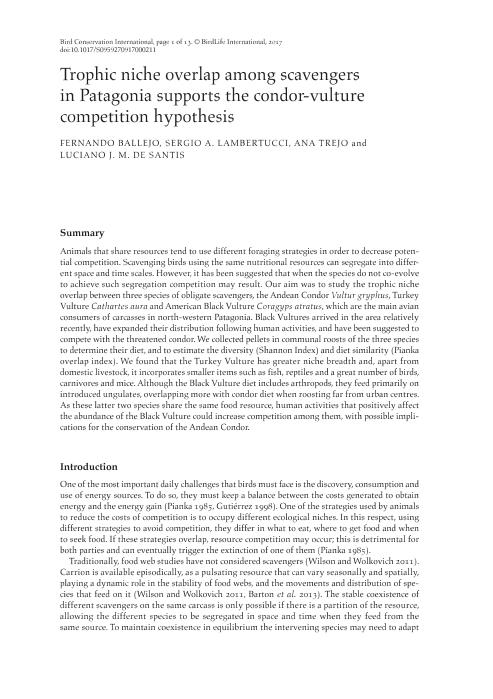Mostrar el registro sencillo del ítem
dc.contributor.author
Ballejo, Fernando

dc.contributor.author
Lambertucci, Sergio Agustin

dc.contributor.author
Trejo, Ana Raquel

dc.contributor.author
De Santis, Luciano J. M.
dc.date.available
2018-11-13T19:15:24Z
dc.date.issued
2017-11-16
dc.identifier.citation
Ballejo, Fernando; Lambertucci, Sergio Agustin; Trejo, Ana Raquel; De Santis, Luciano J. M.; Trophic niche overlap among scavengers in Patagonia supports the condor-vulture competition hypothesis; Cambridge University Press; Bird Conservation International; 28; 3; 16-11-2017; 390-402
dc.identifier.issn
0959-2709
dc.identifier.uri
http://hdl.handle.net/11336/64391
dc.description.abstract
Animals that share resources tend to use different foraging strategies in order to decrease potential competition. Scavenging birds using the same nutritional resources can segregate into different space and time scales. However, it has been suggested that when the species do not co-evolve to achieve such segregation competition may result. Our aim was to study the trophic niche overlap between three species of obligate scavengers, the Andean Condor Vultur gryphus, Turkey Vulture Cathartes aura and American Black Vulture Coragyps atratus, which are the main avian consumers of carcasses in north-western Patagonia. Black Vultures arrived in the area relatively recently, have expanded their distribution following human activities, and have been suggested to compete with the threatened condor. We collected pellets in communal roosts of the three species to determine their diet, and to estimate the diversity (Shannon Index) and diet similarity (Pianka overlap index). We found that the Turkey Vulture has greater niche breadth and, apart from domestic livestock, it incorporates smaller items such as fish, reptiles and a great number of birds, carnivores and mice. Although the Black Vulture diet includes arthropods, they feed primarily on introduced ungulates, overlapping more with condor diet when roosting far from urban centres. As these latter two species share the same food resource, human activities that positively affect the abundance of the Black Vulture could increase competition among them, with possible implications for the conservation of the Andean Condor.
dc.format
application/pdf
dc.language.iso
eng
dc.publisher
Cambridge University Press

dc.rights
info:eu-repo/semantics/openAccess
dc.rights.uri
https://creativecommons.org/licenses/by-nc-sa/2.5/ar/
dc.subject
Scavengers
dc.subject
Diet
dc.subject
Niche Overlap
dc.subject
Patagonia
dc.subject.classification
Otras Ciencias Biológicas

dc.subject.classification
Ciencias Biológicas

dc.subject.classification
CIENCIAS NATURALES Y EXACTAS

dc.title
Trophic niche overlap among scavengers in Patagonia supports the condor-vulture competition hypothesis
dc.type
info:eu-repo/semantics/article
dc.type
info:ar-repo/semantics/artículo
dc.type
info:eu-repo/semantics/publishedVersion
dc.date.updated
2018-10-23T16:18:42Z
dc.journal.volume
28
dc.journal.number
3
dc.journal.pagination
390-402
dc.journal.pais
Reino Unido

dc.journal.ciudad
Cambridge
dc.description.fil
Fil: Ballejo, Fernando. Consejo Nacional de Investigaciones Científicas y Técnicas. Centro Científico Tecnológico Conicet - Patagonia Norte. Instituto de Investigaciones en Biodiversidad y Medioambiente. Universidad Nacional del Comahue. Centro Regional Universidad Bariloche. Instituto de Investigaciones en Biodiversidad y Medioambiente; Argentina
dc.description.fil
Fil: Lambertucci, Sergio Agustin. Consejo Nacional de Investigaciones Científicas y Técnicas. Centro Científico Tecnológico Conicet - Patagonia Norte. Instituto de Investigaciones en Biodiversidad y Medioambiente. Universidad Nacional del Comahue. Centro Regional Universidad Bariloche. Instituto de Investigaciones en Biodiversidad y Medioambiente; Argentina
dc.description.fil
Fil: Trejo, Ana Raquel. Universidad Nacional del Comahue. Centro Regional Universitario Bariloche; Argentina
dc.description.fil
Fil: De Santis, Luciano J. M.. Universidad Nacional de La Plata. Facultad de Ciencias Naturales y Museo; Argentina
dc.journal.title
Bird Conservation International

dc.relation.alternativeid
info:eu-repo/semantics/altIdentifier/url/https://www.cambridge.org/core/product/identifier/S0959270917000211/type/journal_article
dc.relation.alternativeid
info:eu-repo/semantics/altIdentifier/doi/http://dx.doi.org/10.1017/S0959270917000211
Archivos asociados
